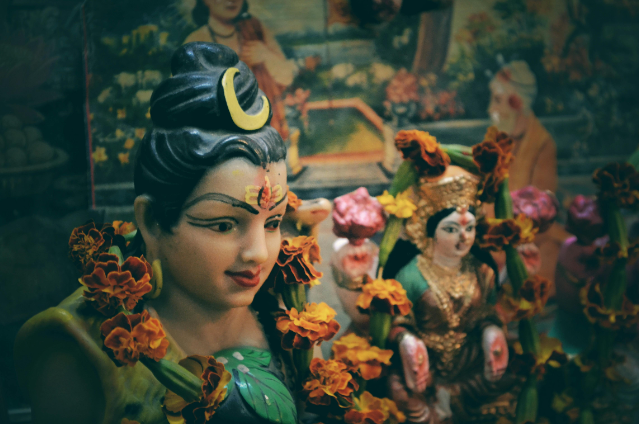
The divine union of consciousness and energy, a lord represents both energies in one body and one soul.
The whole universe is perceived and being created, penetrated, and sustained by two fundamental forces which are permanently in a perfect, indestructible union. These forces or universal aspects are called Shiva and Shakti.
The tradition has associated these principles in a form, respectively, that of a masculine deity and a feminine one. Lord Shiva represents the constitutive elements of the universe, while Shakti is the dynamic potency, which makes these elements come to life and act.
From a metaphysical point of view, the divine Shiva-Shakti corresponds to two essential aspects of the one: the masculine principle, which represents the abiding aspects of God, and the feminine principle, which represents its energy, the force which acts in the manifested world and life itself.
Shakti here stands for the immanent aspect of the divine, that is, the act of active participation in the act of creation. This view of the feminine in creation contributed to the orientation of the human being towards the active principles of the universe, rather than towards those of pure transcendence.
Therefore, Shiva defines the traits specific to pure transcendental and is normally associated, from this point of view, with a manifestation of Shakti, who is a somewhat stronger personification of her own untamed and limitless manifestation.
The fact is, Shakti is more accessible to human understanding because this regards aspects of life closely related to the human condition inside the creation. The cult of the Goddess has spread more forcibly.
The 5 Powers of Shakti
Many aspects, forms, and names of Shakti are the mother of all. In creation, she distinguishes herself, or through the will of Shiva, into three basic aspects:
- Para Shakti (transcendental energy)
- Aparna Shakti (immanent energy)
- Para-apara Shakti (an intermediary energy)
In the texts of Shaivism, there is reference to the five supernatural powers of Shakti, awakened in himself by Shiva. Their permutation, combination, concealment, and manifestation are believed to be responsible for the multiplicity, plurality, diversity, and duality of the beings and objects and their forms and shapes in the manifested worlds. The five aspects of Shakti manifested by Shiva are:
- Chit Shakti – the power of consciousness
- Ananda Shakti – the power of bliss consciousness
- Iccha Shakti – the power of desire or will
- Kriya Shakti – the power of action
- Jnana Shakti – the power of knowledge
Shiva Shakti Story
The marriage of Shiva and Shakti is related to one of the most important occasions— the festival of Mahashivratri. This story emphasises the narration of how Lord Shiva married a second time to Shakti. According to the Shiva and Shakti legend, the day Lord Shiva got married to Parvati is celebrated as Shivratri – the night of Lord Shiva.
The legend goes that once Lord Shiva and his wife Sati, or Shakti, were returning from Sage Agastya’s ashram after listening to Ram Katha or the story of Ram. On their way through a forest, Shiva saw Lord Rama searching for his wife Sita, who had been kidnapped by Ravana, the king of Lanka. Lord Shiva bowed his head in reverence to Lord Rama. Sati was surprised by Lord Shiva’s behaviour and inquired why he was paying obeisance to a mere mortal. Shiva informed Sati that Rama was an incarnation of Lord Vishnu. Sati, however, was not satisfied with the reply and was asked by Shiva to go and verify the truth for herself.
Using her power to change forms, Sati took the form of Sita and appeared before Rama. Lord Rama immediately recognised the true identity and asked Devi, “Why are you alone? And where is Lord Shiva?” At this point, Sati realised the truth of Lord Rama. But Sita was like a mother to Lord Shiva, and since Sati took the form of Sita, her status changed. From that time, Shiva detached himself from her as a wife. Sati was saddened by the change in Lord Shiva. Hence, she stayed on Mount Kailash, the abode of Lord Shiva.
Later, Sati’s father Daksha arranged a yagna, where he didn’t invite Sati and Lord Shiva, as he was in an altercation in the court of Brahma. But Sati wanted to attend the yagna even though Lord Shiva didn’t appreciate her idea, and she felt humiliated when Daksha ignored her presence and didn’t offer prasad for Lord Shiva. Hence, she jumped into the yagna fire and immolated herself. Lord Shiva became extremely furious when he heard the news of Sati’s immolation. Carrying the body of Sati, Shiva began to perform Rudra Tandava or the dance of destruction and wiped out the kingdom of Daksha. Rudra Tandava had the power to destroy the entire universe. Lord Vishnu, to calm Lord Shiva, severed Sati’s body into 12 pieces and threw them on earth. These emerged as Shakti Peethas, including Kamakhya in Assam and Vindhyavasini in UP.
Lord Shiva undertook rigorous penance and retired to the Himalayas. In the form of Parvati, Shakti took reincarnation. She performed penance to break Shiva’s meditation and win his attention. It is said that Parvati struggled hard to break Lord Shiva’s meditation, but through her devotion and the persuasion of sages and Devas, she somehow lured Lord Shiva into marriage and away from asceticism. Their marriage was solemnised a day before Amavasya in the month of Phalgun. This day of union is celebrated as Mahashivratri every year.
But in the recent era, people don’t have much energy to attract their partners. They start judging based on situations. They don’t wait or fix things to work out. They simply end things on their own, even for a trivial issue which can be solved by talking with heart out.
References:
Wikipedia.org
